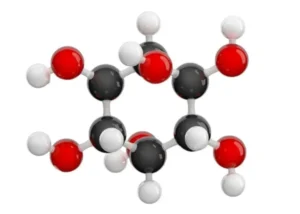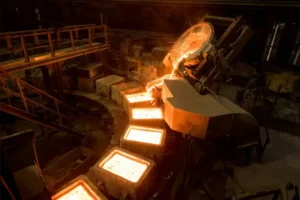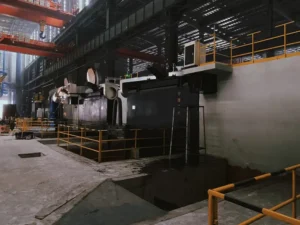
From a physical metallurgy viewpoint, this article delves into the dissolution mechanisms and diffusion rates of alloys with high melting points and low densities in molten iron. It also offers optimization strategies to effectively prevent compositional segregation and ensure final product quality.
In the melting shop of a steel plant, adding alloy lumps to molten steel for composition adjustment is a critical step in guaranteeing the performance of the final product. যাহোক, a common technical challenge is the non-uniform melting of these alloys, which directly leads to compositional segregation, performance fluctuations, and even the scrapping of an entire heat of steel. The root cause lies in the complex physicochemical interactions between different alloying elements and the molten iron—a problem of alloy dissolution kinetics.
This article will focus on two representative alloys: tungsten (W), with a high melting point and high density, and titanium (এর), with a relatively low melting point but a density significantly lower than molten iron. From the perspective of physical metallurgy, we will deeply analyze the differences in their dissolution mechanisms and diffusion rates in molten iron and, based on this, propose a series of effective optimization strategies.
আমি. Dissolution Mechanism, Not Just “গলে যাওয়া,” but a Complex Physicochemical Process
When an alloy lump is added to high-temperature molten iron, it doesn’t simply “melt” like an ice cube in hot water. বাস্তবে, it is a complex process involving heat transfer, mass transfer, and phase transformation. Its dissolution rate is primarily constrained by two key steps: interfacial reaction এবং mass transfer (diffusion).
High-Melting-Point Alloys (যেমন, Tungsten): Dissolution Controlled by Both Interfacial Reaction and Diffusion
Tungsten’s melting point is 3422°C, far exceeding the typical steelmaking temperature of around 1600°C. অতএব, a tungsten lump cannot melt directly. Its dissolution process follows these steps:
- Initial Solidified Shell and Remelting: When a cold tungsten lump is introduced into the molten iron, a solidified shell of iron instantly forms on its surface. As heat is transferred from the molten iron to the tungsten lump, this iron shell remelts.
- Interfacial দ্রবীভূত and Diffusion: After the iron shell remelts, tungsten atoms begin to dissolve into the molten iron at the solid-liquid interface. This is not simple melting but an atomic-level dissolution process. The dissolved tungsten atoms form a high-concentration boundary layer at the interface.
- Mass Transfer by Diffusion: Driven by the concentration gradient, the tungsten atoms in the boundary layer diffuse into the bulk of the molten iron. This diffusion process is crucial for determining whether the tungsten can be uniformly distributed.
Bottlenecks for Slow Tungsten দ্রবীভূত:
- High Melting Point and Low দ্রবণীয়তা: The extremely high melting point signifies very strong atomic bonds in tungsten, requiring immense energy for atoms to detach from the crystal lattice and dissolve. অতিরিক্তভাবে, tungsten has limited saturation solubility in molten iron.
- Formation of Intermediate Phases: According to the Fe-W phase diagram, iron and tungsten can form high-melting-point intermetallic compounds (যেমন, Fe₇W₆) at the interface. This dense intermediate layer acts as a diffusion barrier, severely hindering further dissolution and diffusion of tungsten atoms into the molten iron.
- High Density: Tungsten’s density (19.3 g/cm³) is much higher than that of molten iron (approx. 7 g/cm³), causing it to sink rapidly to the furnace bottom. Without effective stirring, it is extremely difficult to distribute it evenly throughout the melt pool.
Low-Density Alloys (যেমন, টাইটানিয়াম): Dissolution Influenced by Buoyancy, Oxidation, and Exothermic Reactions
Titanium’s melting point (1668° সে) is close to steelmaking temperatures, but its density (4.5 g/cm³) is much lower than that of molten iron. This dictates its unique dissolution behavior:
- Flotation and Melting: Due to its low density, titanium alloy lumps float on the surface of the molten iron, making immersion difficult. This causes it to melt only from the lower surface in contact with the melt, leading to low overall melting efficiency.
- Strong Oxidizing Tendency: Titanium is a strong deoxidizer with a high affinity for oxygen in the molten iron or the atmosphere. During melting, titanium rapidly reacts with oxygen to form a layer of high-melting-point oxides like TiO₂ and Ti₂O₃ on its surface. This oxide “shell” envelops the unmelted titanium, preventing further contact and dissolution into the molten iron.
- Exothermic দ্রবীভূত Effect: The dissolution of titanium in molten iron is a strong exothermic process. This raises the local temperature around the titanium alloy lump, accelerating its own dissolution and potentially causing local overheating. যাহোক, if not controlled, this self-accelerating effect can exacerbate non-uniformity.
Ii. Diffusion Rate: A Race of Atomic Migration
The final homogenization of alloying elements in molten iron depends on their atomic diffusion capabilities. The diffusion rate is mainly influenced by তাপমাত্রা, concentration gradient, the element’s own characteristics (atomic radius, interaction with iron), এবং flow state of the melt.
- Diffusion of Tungsten (W): Tungsten has a larger atomic radius and a strong interaction with iron atoms, tending to form intermetallic compounds. This results in a relatively low diffusion coefficient in liquid iron. Studies have shown that at 1873K (1600° সে), the diffusion coefficient of tungsten in liquid iron is on the order of (2.2 – 3.5) x 10⁻⁹ m²/s. Slow diffusion is a primary cause of tungsten segregation.
- Diffusion of টাইটানিয়াম (এর): Titanium’s atomic radius is similar to iron’s, and it has high solubility in molten iron. In theory, its diffusion rate should be faster than tungsten’s. যাহোক, due to its propensity to form oxides and nitrides, these fine inclusions can hinder liquid-phase mass transfer. আরও, its flotation characteristic makes macroscopic mixing far more critical than atomic diffusion.
সংক্ষেপে, the challenge in homogenizing tungsten lies in its slow interfacial dissolution and atomic diffusion. For টাইটানিয়াম, the challenge is more about overcoming buoyancy to effectively enter and distribute throughout the molten iron, while preventing it from being “encapsulated” by oxides.
Iii. Optimization Strategies: How to Make Your Alloys “Behave”
To address the aforementioned dissolution kinetics challenges, the following process optimization strategies can be adopted to promote uniform alloy melting and prevent compositional segregation.
1.Rational Feeding Methods
- Preheating: Preheating high-melting-point, high-density alloys (like ferro-tungsten, ferro-molybdenum) can significantly shorten the initial solidified shell period, accelerate the dissolution rate, and reduce the local temperature drop in the melt pool.
- Batch and Small-Quantity Feeding: Avoid adding a large quantity of alloy at once. Adding it in batches helps maintain a stable melt temperature and provides sufficient time for the previously added alloy to dissolve and diffuse. For low-density alloys like titanium, adding in smaller quantities allows for better control over its melting location, facilitating stirring.
- Adjusting the Addition Sequence: Add high-melting-point, difficult-to-dissolve alloys first, followed by easily melted and easily oxidized alloys. উদাহরণ স্বরূপ, adding titanium after the molten steel has been well-deoxidized can minimize its oxidation loss.
2.Enhancing Melt Stirring
Stirring is the most effective means to overcome diffusion bottlenecks and promote macroscopic mixing. Strong melt flow can wash away the high-concentration boundary layer at the interface and rapidly transport newly dissolved alloy atoms to all parts of the melt pool.
- Adjusting Power for Electromagnetic Stirring (EMS): For electric arc furnaces or refining furnaces, optimizing the current and frequency of the induction coils can generate powerful electromagnetic forces, driving vigorous movement of the molten steel. This is crucial for drawing sunken tungsten or floating titanium into the main flow of the melt.
- Gas Stirring (Argon): Injecting argon gas through porous plugs at the bottom of the furnace utilizes the buoyancy of the rising bubbles to stir the molten steel. This is a very effective method for full-pool stirring, particularly suitable for LF refining furnaces, and can effectively address the flotation of low-density alloys and the settling of high-density ones.
- Optimizing Tapping Stream and Feeding Location: Alloying during tapping, by utilizing the turbulence as molten steel is poured from the ladle into the tundish or mold, can leverage the fluid’s kinetic energy to promote mixing. অতিরিক্তভাবে, adding alloys to the most intensely stirred zones (যেমন, near the electrode hot spots or in the argon blowing plume) can significantly improve efficiency.
3.Optimizing Alloy Properties
- Selecting Appropriate Alloy Particle Size: For high-melting-point alloys, oversized lumps mean longer dissolution times. Crushing them to a suitable size increases the specific surface area and accelerates dissolution. যাহোক, for easily oxidized titanium, excessively fine powder can exacerbate burn loss.
- Using Master Alloys: Using pre-made master alloys with lower melting points (such as ferro-tungsten or ferro-titanium) instead of pure metals is standard industrial practice. This effectively lowers the melting temperature of the alloying element and improves its wettability and solubility in molten iron.
উপসংহার
The non-uniform melting of alloys is a direct manifestation of limited dissolution kinetics. Whether it’s the “sinking and slow dissolution” of tungsten or the “floating and easy oxidation” of titanium, there are profound physical metallurgy principles at play. A deep understanding of the dissolution mechanisms and diffusion characteristics of different alloying elements, combined with the targeted implementation of optimization strategies such as preheating, batch feeding, and vigorous stirring, is the essential path to resolving compositional segregation and achieving high-quality, stable production of steel products.







